
In botany, a bud is an undeveloped or embryonic shoot and normally occurs in the axil of a leaf or at the tip of a stem. Once formed, a bud may remain for some time in a dormant condition, or it may form a shoot immediately. Buds may be specialized to develop flowers or short shoots or may have the potential for general shoot development. The term bud is also used in zoology, where it refers to an outgrowth from the body which can develop into a new individual.
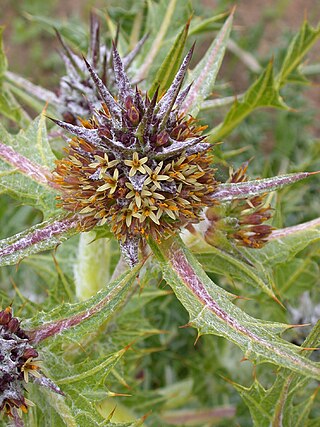
Gundelia or tumble thistle is a low to high (20–100 cm) thistle-like perennial herbaceous plant with latex, spiny compound inflorescences, reminiscent of teasles and eryngos, that contain cream, yellow, greenish, pink, purple or redish-purple disk florets. It is assigned to the family Asteraceae. Flowers can be found from February to May. The stems of this plant dry-out when the seeds are ripe and break free from the underground root, and are then blown away like a tumbleweed, thus spreading the seeds effectively over large areas with little standing vegetation. This plant is native to the eastern Mediterranean and the Middle-East. Opinions differ about the number of species in Gundelia. Sometimes the genus is regarded monotypic, Gundelia tournefortii being a species with a large variability, but other authors distinguish up to nine species, differing in floret color and pubescence. Young stems are cooked and eaten in the Middle-East and are said to taste like a combination of artichoke and asparagus.

Leucospermum is a genus of evergreen upright, sometimes creeping shrubs that is assigned to the Proteaceae, with currently forty-eight known species.
This page provides a glossary of plant morphology. Botanists and other biologists who study plant morphology use a number of different terms to classify and identify plant organs and parts that can be observed using no more than a handheld magnifying lens. This page provides help in understanding the numerous other pages describing plants by their various taxa. The accompanying page—Plant morphology—provides an overview of the science of the external form of plants. There is also an alphabetical list: Glossary of botanical terms. In contrast, this page deals with botanical terms in a systematic manner, with some illustrations, and organized by plant anatomy and function in plant physiology.
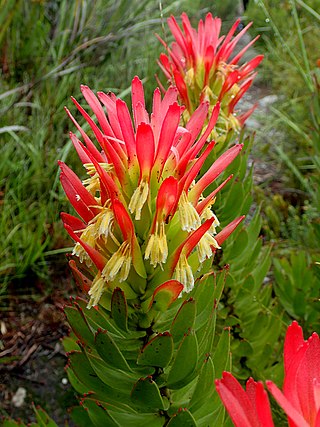
Mimetes cucullatus is an evergreen shrub with several, mostly not branching, upright stems of 1–2 m (3–7 ft) high, that has been assigned to the family Proteaceae. It is the most widespread and most common pagoda species that can cope with a relatively large range of environmental circumstances. It is known under several names including common pagoda in English and rooistompie in Afrikaans.
This glossary of botanical terms is a list of definitions of terms and concepts relevant to botany and plants in general. Terms of plant morphology are included here as well as at the more specific Glossary of plant morphology and Glossary of leaf morphology. For other related terms, see Glossary of phytopathology, Glossary of lichen terms, and List of Latin and Greek words commonly used in systematic names.

Phaneroglossa is a genus of plants that is assigned to the daisy family. It consists of only one species, Phaneroglossa bolusii, a perennial plant of up to 40 cm high, that has leathery, line- to lance-shaped, seated leaves with mostly few shallow teeth and flower heads set individually on top of long stalks. The flower head has an involucre of just one whorl of bracts, few elliptic, white or cream ray florets, and many yellow disc florets. It is an endemic species of the Western Cape province of South Africa. Flowering mainly occurs from November to January.
Munzothamnus is a monotypic genus of flowering plants in the family Asteraceae containing the single species Munzothamnus blairii, which is known by the common name Blair's wirelettuce, or Blair's munzothamnus. It is endemic to San Clemente Island, one of the Channel Islands of California. It grows along steep, rocky cliffsides and canyons on the island. It is a shrub producing a fleshy, woolly stem usually over a meter in height, often approaching two meters. Leaves occur in tufts at the ends of the stem branches. They are up to 15 centimeters long, oblong in shape, and sometimes very shallowly lobed. They are woolly when new but lose their hairs and become shiny green with age. The inflorescence is a large array of up to 35 flower heads. Each head has a cylindrical base under a centimetre long and contains 9 to 12 light lavender or pinkish flowers. Each flower is a ray floret with an erect tube and a strap-shaped ligule with a toothed tip. The ligule is just under a centimetre long. The fruit is a cylindrical, ribbed achene with a white pappus.
Prenanthella is a monotypic genus of flowering plants in the family Asteraceae. It contains the single species Prenanthella exigua, which is known by the common name brightwhite. It is native to the southwestern United States from California to Texas and it is known as far north as Idaho. Its habitat includes desert and woodlands. This annual herb produces a slender, branching stem reaching a maximum height near 40 centimeters. It has a sparse coating of glandular hairs and contains a milky juice. Most of the leaves are located near the base of the stem. They are widely lance-shaped and sometimes divided into segments. Smaller leaves occur higher on the stem; these may be reduced to scale-like structures, leaving the stem mostly bare. The inflorescence is a wide open panicle of several flower heads. Each small head is cylindrical and narrow, its base wrapped in lance-shaped phyllaries. At the tip of the head bloom 3 or 4 flowers, which are ray florets; there are no disc florets. Each floret has is white to pale pink and has a toothed tip. The fruit is a white achene with a pappus of white bristles.
Cavea is a low perennial herbaceous plant that is assigned to the family Asteraceae. Cavea tanguensis is currently the only species assigned to this genus. It has a basal rosette of entire, slightly leathery leaves, and stems of 5–25 cm high, topped by bowl-shaped flower heads with many slender florets with long pappus and purplish corollas. The vernacular name in Chinese is 葶菊. It grows high in the mountains of China (Sichuan), Tibet, India (Sikkim), and Bhutan, and flowers in July and August.

In plant morphology, thorns, spines, and prickles, and in general spinose structures, are hard, rigid extensions or modifications of leaves, roots, stems, or buds with sharp, stiff ends, and generally serve the same function: physically defending plants against herbivory.

Stephanomeria virgata, commonly called rod wirelettuce, twiggy wreath plant, and virgate wirelettuce, is a herbaceous annual plant of the family Asteraceae. It can be found growing in Western North America, specifically California, but also in Oregon and Nevada and northern Mexico. This plant can be found in dry, open habitat types at elevations below 2100 meters. S. virgata is sometimes used as an ornamental plant.
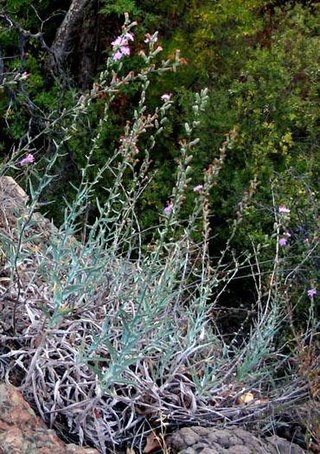
Stephanomeria cichoriacea is a species of flowering plant in the family Asteraceae; it is known by the common names chicoryleaf wirelettuce and silver rock-lettuce. It is endemic to California, where it grows in the coastal mountain ranges as far north as Monterey County, but especially in southern California mountains such as the Transverse Ranges. Its habitat includes chaparral. It is a perennial herb producing slender erect stems reaching maximum heights exceeding one meter. The stem is woolly with hairs, especially on new growth. The leaves are mostly located in a basal rosette, the largest reaching 18 to 20 centimeters long. They are lance-shaped and often toothed along the edges, and the newer ones are woolly. Smaller leaves occur farther up the stem. The inflorescence is a long array of several flower heads, with some occurring in the upper leaf axils as well. Each head has a cylindrical base 1 to 2 centimeters long which is lined with layers of glandular phyllaries. The head contains 10 to 15 ray florets, each with an elongated tube and a pink ligule which may be up to 2 centimeters long. The fruit is an achene tipped with a spreading cluster of long, plumelike pappus bristles.
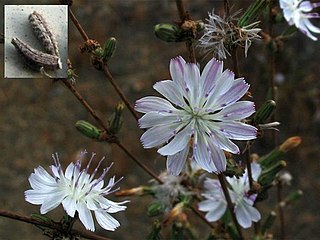
Stephanomeria diegensis is a species of flowering plant in the family Asteraceae known by the common name San Diego wirelettuce. It is native to the coastal hills and ranges of southern California and Baja California, where it grows in many types of open habitat. It evolved as a hybrid of Stephanomeria exigua and S. virgata. Furthermore, it is thought to be the result of homoploid hybrid speciation, which is uncommon. The plant is frequently misidentified as one of its parents, especially if older taxonomic keys are used. This is an erect annual herb easily exceeding two meters in height. Its slender stem has many spreading branches. The basal leaves are linear to lance-shaped and up to 10 centimeters long. The leaves wither early and are absent for most of the year, giving the plant a twiglike appearance. Leaves on the upper stem are small and reduced. The inflorescences are usually clusters of flower heads located at intervals on the stiff branches. Each head has a cylindrical base lined with phyllaries. These are often glandular. The head contains several ray florets, each with an elongated tube and a white or pink-tinged ligule measuring around a centimeter long. The fruit is a grooved achene tipped with a spreading cluster of long, plumelike pappus bristles.
Stephanomeria elata is a species of flowering plant in the family Asteraceae known by the common names Santa Barbara wirelettuce and Nuttall's wirelettuce. It is native to Oregon and California, where it grows in coastal and inland mountain ranges, including the Sierra Nevada. It can be found in many types of habitat. It is an annual herb producing a slender, erect stem often exceeding one meter in maximum height. It is hairy to hairless and often glandular. The leaves are mostly located in a basal rosette, the largest reaching 10 centimeters long. Smaller, much-reduced leaves occur farther up the stem. The leaves drop early, leaving the plant naked for most of the year. Flowers occur singly or in small clusters along the stiff branches. Each head contains up to 15 or 16 ray florets, each with an elongated tube and a pink ligule 6 or 7 millimeters long. The fruit is an achene tipped with a spreading cluster of long, plumelike pappus bristles.

Stephanomeria lactucina is a species of flowering plant in the family Asteraceae known by the common names lettuce wirelettuce and woodland wirelettuce. It is native to Oregon and California, where it grows in coastal and inland mountain ranges, including the Sierra Nevada. It can be found in many types of habitat, including coniferous forests. It is rhizomatous perennial herb producing a slender, erect stem reaching 30 to 60 centimeters in maximum height. The linear or lance-shaped leaves are up to 8 centimeters long and their edges are lined with widely spaced teeth. Solitary flower heads occur on erect peduncles. Each head contains up to 10 ray florets, each with an elongated tube and a fringed pink ligule roughly a centimeter long. The fruit is an achene tipped with a spreading cluster of long, plumelike pappus bristles.
Stephanomeria paniculata is a species of flowering plant in the family Asteraceae known by the common names tufted wirelettuce and stiff-branched wirelettuce. It is native to the northwestern United States, where it grows in many types of habitat, including disturbed areas. It is an annual or biennial herb producing a slender, erect stem with stiff, widely spreading branches toward the top. It is hairless. The leaves are mostly located in a basal rosette, the largest reaching 10 centimeters long. Smaller, linear leaves occur along the upper stem. Flower heads occur singly or in small clusters along the stiff branches. Each head contains 4 to 6 ray florets, each with an elongated tube and a pinkish or lavender ligule up to 1.4 centimeters long. The fruit is an achene tipped with a spreading cluster of long, white pappus bristles.
Stephanomeria parryi is a species of flowering plant in the family Asteraceae known by the common name Parry's wirelettuce. It is native to the southwestern United States, where it grows in many types of habitat, including many desert areas. It is a perennial herb growing from a thick root and producing one or more slender, upright stems up to about 40 centimeters tall. The green leaves are linear to lance-shaped with lobed edges and are up to 8 centimeters long near the base of the plant. Flower heads occur on the spreading branches. Each has up to 13 or 14 ray florets, each with an elongated tube and a whitish ligule up to 1.5 centimeters long. The fruit is an achene tipped with a spreading cluster of long, tan, plumelike pappus bristles.

Stephanomeria pauciflora is a species of flowering plant in the aster family known by the common names brownplume wirelettuce, few-flowered wirelettuce, and prairie skeletonplant. It is native to the southwestern United States and northern Mexico, where it grows in many types of habitat, including many desert areas, woodlands, and plains. It is a perennial herb or bushy subshrub producing one or more sturdy, stiff stems with many spreading branches, taking a rounded but vertical form. The leaves are mostly basal and ephemeral, with smaller, scale-like leaves occurring on the upper stem. Flower heads occur at intervals along the mostly naked stems, especially near the tips. Each has a cylindrical base covered in hairless phyllaries. It contains 3 to 6 florets, each with an elongated tube and a flat pink ligule. The fruit is an achene tipped with a spreading cluster of plumelike pappus bristles. These are usually brownish, but are sometimes white. The specific epithet pauciflora, refers to the Latin term for 'few flowered'.
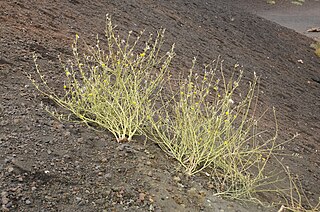
Chondrilla is a genus of flowering plants in the family Asteraceae. They are native to Eurasia, and certain taxa are known as introduced species outside their native range. The best known of these is rush skeletonweed, a noxious weed established in Africa, Australia, and the Americas.












